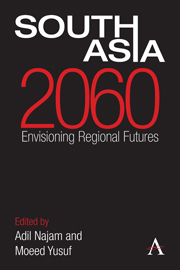Book contents
- Frontmatter
- Contents
- Acknowledgments
- List of Abbreviations
- Introduction: Imagining South Asian Futures
- Section I South Asia as a Region
- Section II State Relations
- Chapter 6 The Future of Democracy
- Chapter 7 Conflict and Reconciliation: Three Scenarios
- Chapter 8 Religion and State Formation
- Chapter 9 Will South Asia Still Be Terrorism's Center of Gravity?
- Chapter 10 Speculations on Nuclear South Asia
- Chapter 11 Nuclear Risk: Overstated or Underrated?
- Chapter 12 The Shadow of the India–Pakistan Stalemate
- Chapter 13 Regional Integration
- Chapter 14 The Future of Integration
- Chapter 15 The Giant Neighbor: Why is China Important?
- Section III Development
- Section IV Human Well-Being
- About the Authors
- Bibliography
- Index
Chapter 10 - Speculations on Nuclear South Asia
from Section II - State Relations
Published online by Cambridge University Press: 05 September 2013
- Frontmatter
- Contents
- Acknowledgments
- List of Abbreviations
- Introduction: Imagining South Asian Futures
- Section I South Asia as a Region
- Section II State Relations
- Chapter 6 The Future of Democracy
- Chapter 7 Conflict and Reconciliation: Three Scenarios
- Chapter 8 Religion and State Formation
- Chapter 9 Will South Asia Still Be Terrorism's Center of Gravity?
- Chapter 10 Speculations on Nuclear South Asia
- Chapter 11 Nuclear Risk: Overstated or Underrated?
- Chapter 12 The Shadow of the India–Pakistan Stalemate
- Chapter 13 Regional Integration
- Chapter 14 The Future of Integration
- Chapter 15 The Giant Neighbor: Why is China Important?
- Section III Development
- Section IV Human Well-Being
- About the Authors
- Bibliography
- Index
Summary
The conflict between India and Pakistan may be the most serious and imminent danger to the South Asian region and to humanity over the next 50 years. During this period, India and China will continue their rise as great powers and rivals, even if they do not become peers of the United States. This will ensure that Pakistan remains at the heart of regional and global politics for decades to come.
We examine the dynamics of the India–Pakistan nuclear relationship and how it may evolve, especially as it becomes increasingly part of a larger set of strategic relationships involving the United States and China. At the same time, Islamist politics in Pakistan, which may gather strength in coming decades, seeks to more directly confront India and the West. We look in particular at the risk of nuclear war and of nuclear terrorism. We consider also how India and Pakistan might respond to the renewed global effort to eliminate nuclear weapons.
There is another nuclear danger growing in South Asia. India and Pakistan have relied on nuclear energy for electricity production on a small scale for decades and have ambitious plans for expanding their respective programs. Other countries in the region have been seeking to start their own programs. This is part of a renewed worldwide interest in nuclear energy. But the March 2011 Fukushima nuclear disaster in Japan offers a stark reminder of the ever-present danger of nuclear accidents.
- Type
- Chapter
- Information
- South Asia 2060Envisioning Regional Futures, pp. 82 - 89Publisher: Anthem PressPrint publication year: 2013



